Socio-cultural Impact of the Delhi Sultanate UPSC Notes
Socio-cultural Impact of the Delhi Sultanate
The Delhi sultanate introduced Persian art, architecture, and language, fostering a blend of Indian and Islamic cultures. It led to grow the Indo-Islamic art and the spread of Islam in India.
Economy of Delhi Sultanate
Agriculture
- North part of the empire produced Wheat, Oilseed East and south had rice and sugarcane.
- Two crops per year could be produced as the soil was fertile. Rice was grown three times a year. Other crops grown were Sesame, Indigo and Cotton.
- Reforms under Muhammad-Bin-Tughlaq (1325-1351)
-
- Increased the land revenue of the Doab region, due to which the peasants started abandoning their lands.
- Introduced Takkavi Loans to farmers to arrest the abandonment due to high rates of rent (Kharaj). However, this led to a debt trap for farmers, due to which Firoz Shah had to write off these loans.
- Established a separate agricultural department Diwan-i-Kohi.

Industry
- Village industries consisted of oil pressing, making of Jaggery, weaving and dyeing of cloth, etc.
- New techniques/crafts introduced by Turks –
- Paper-making industry.
- Introduction of spinning wheel and cotton carder’s bow (Dhunia).
| Region | Famous for |
| Gujarat and Bengal | Cloth of fine quality |
| Cambay in Gujarat | Raw silk and fine cotton cloth (Muslin). |
| Region | Items imported from here |
| West Asia | High-grade textiles (Satin, etc.), glassware, horses. |
| Southeast Asia | Spices |
| China | Raw Silk and Porcelain |
| Africa | Ivory |
- Karkhanas: These were the manufacturing centres working under the State.
- The Karkhana met the need of the royal households. Nobles holding the rank of Malik or Khan supervised the Karkhanas.
- A separate Dewan or account office existed for Karkhanas, headed by the next supervisor,
- Reforms under Alauddin Khalji
- Banjaras transported food grains under the supervision of an official called Shahna-i-Mandi.
- The foods were then brought to Mandis and sold at official prices.
- The cloth, dry fruits etc. market was called Sarai-i-Adl. Officer Rais parwana supervised the fabric and garments.
- Barid-i-Mandi were the intelligence officer of the market, and Munhiyan were the secret spy.
- All these markets fell under the department of Diwan-i-Riyasat (department of commerce) and the office of Nazir (superintended of weights and measure).
Delhi Sultanate Currency
- Dehliwal Coins – The early Ghurid conquerers minted these coins. These were of copper and significantly less silver. The coins bore the image of goddess Lakshmi or bull-and-horseman, etc. The name of the new ruler was inscribed in it in Nagri Script.
- Coins of Delhi Sultanate
- Iltutmish standardised the coin system by introducing gold and silver Tankas and a copper jital.
- Delhi sultanate made coins of gold, silver and Billon (copper mixed with a minimal quantity of silver). Barani mentions dirams and dangs, which were used in the capital Delhi.
- The relation between the coins was –
1 silver tanka = 48 jital = 192 dangs = 480 dirams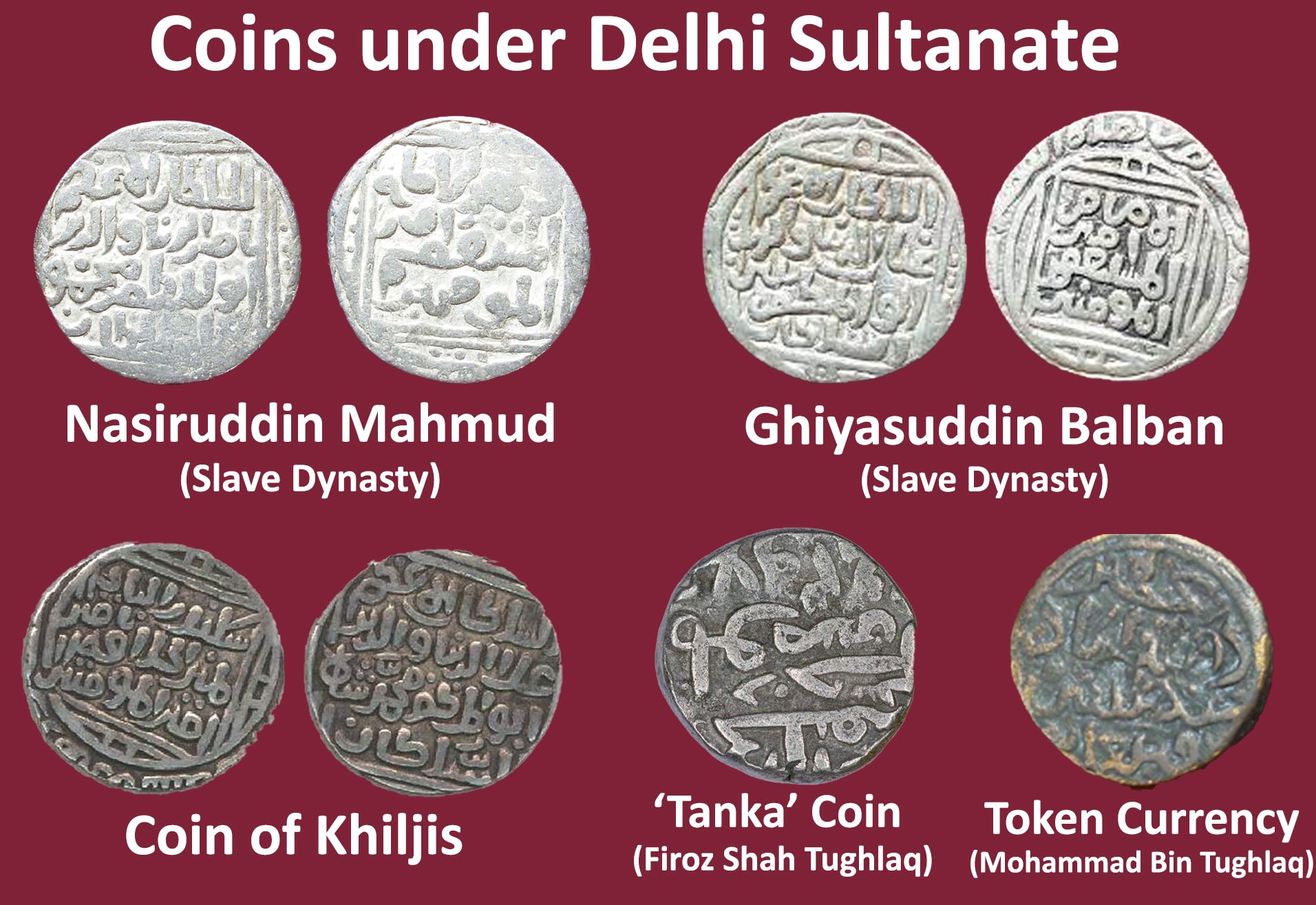
- Introduction of token currency: Muhammad-Bin-Tughlaq started the circulation of the token currency of copper coins in 1329-30. These token coins had value at par with silver coins. Due to forging, and lack of trust among the subjects and foreign merchants, Muhammad Bin Tughlaq recalled the token currency around 1331-32.
- Firoz Shah Tughlaq (1351-1388) introduced new coins, Adha, Bikh, Shashgani and Hastgani.
Taxes and revenue terms
| Taxes and Revenue terms | Description |
| Kharaj | land revenue |
| Wafa-i-farmani | Officially decreed yields for the Kharaj assessment |
| Nirkh-i-farmani | Officially decreed prices for the Kharaj assessment |
| Ghari | House tax |
| Charah | The grazing tax was introduced by Alauddin Khalji. |
| Ushr | land revenue realised from Muslims only. |
| Jaziya | The religious tax imposed on non-Muslims |
| Zakat | Religious tax paid by wealthy Muslims |
| Ghanimat | the booty captured during the war. |
| Khams | the 1/5th part of the war captured money to be deposited in the royal treasury. |
| Haqq-i-Sharb | Tax on irrigation (water tax) introduced by Feroz Shah |
| Bhoga | A cess |
- Land Revenue(Kharaj) became very high: Alauddin Khalji increased the land revenue by 50% and eliminated all the intermediaries, such as Khut and
- Assessment of the Revenue:
- Alauddin Introduced that the measurement of land is the basis of determining the revenue. Biswa (1/20th of a Bigha) was the standard unit of measurement.
- Firoz Shan permanently fixed the estimated revenue (Jama) of the Sultanate by implementing a six-year crop production survey.
- New Taxes:
- Alauddin introduced two new types of taxes –
- Ghari (House tax) and
- Charai (Grazing tax).
- Firoz Shah introduced an irrigation tax (Haqq-i-Sharb) imposed on those who used state canals for irrigation.
- Alauddin introduced two new types of taxes –
- Types of Lands on the basis of Revenue Assessment: All land was divided into three types.
- Iqta Land was awarded to the Nobles for the collection of revenue in exchange for their contribution of soldiers and horses for the Sultanate army. However, this system made the Nobles who held Iqtas (Iqtadars) very powerful.
- Khalisa Land – The revenue from this land became the personal disposable income of the Sultan.
- Inam land was awarded to religious institutions and therefore was often referred to as the Imam land.
- Alauddin Changes to the system:
- Most of the Iqtas were abolished, and the Iqta land was brought under the crown and was called Khalisa. The State directly collected the land revenue under Khalisa However, this led to resentment from the Nobles and ultimately to the downfall of Khalis.
- He established a new department called Diwan-i-Mustakharaj, which collected the dues or arrears from the revenue collectors.
- He reversed the share of Khams (the State’s share of the loot) and the loot to be distributed among the soldiers.
- The policy of Religious Taxation:
-
- Firoz Shah abolished as many as 23 taxes and imposed taxes per Shariya law – Kharaj, Jaziya, Zakat and
- Generally, Brahmins were excluded from Jaziya, but Firoz Shah included them too.
Society of Delhi Sultanate
- Peasants formed the majority of the population, most of which worked hard and lived under subsistence. Some peasants were prosperous. They dominated the village panchayat and were considered the original settlers of the village.
- The village headmen (muqaddams) and smaller landlords (khuts) enjoyed a higher standard of life.
- They rode fine Iraqi and Arabi They sometimes forced ordinary peasants to pay their share of land revenue. Alauddin Khalji took stern action against them.
- The Hindu Rais, or autonomous rajas, also enjoyed a higher standard of life. They continued to hold their previous estates. They frequently visited the court of
- Merchants:
- Marwaris and Gujaratis, many of whom were Jains, dominated the coastal trade and trade between the coastal ports and north India.
- The Muslim Bohra merchants also participated in this trade.
- Multanis mainly were Hindus, and some Muslim Multanis included Khurasanis, Afghans, Iranians, etc. They participated in the overland trade with Central and West Asia.
- Nobles had a high standard of living comparable to the world’s highest standard at that time.
- However, some rulers like Iltutmish, Alauddin Khalji and Mohammad bin Tughlak tried to repress the nobles in order to curtail their power.
- Women –
- Their condition remained the same.
- Child marriage and the wife’s obligation of service and devotion to the husband continued.
- Annulment of marriage was only allowed in exceptional circumstances such as desertion and disease.
- Widow remarriage was prohibited, and the practice of sati
- The practice of Purdah became widespread among the upper class of women.
Delhi Sultanate Religion
- The Delhi sultanate was a theocratic state (government by divine guidance) based on Islam, and the Sultans followed Sharia (Islamic laws).
- Some rulers, such as Balban, had recognition from the
- They appointed Muslim religious figures to profitable state offices and granted them revenue-free lands.
- The Hindus were given the status of zimmis or protected people.
- Jaziya tax was imposed on the Hindus.
- Women, children and the poor having insufficient means were exempted from Jaziya.
- The Brahmans were exempted, but Firoz Shah Tughlaq included the Brahmins in the Jaziya tax.
- The Sufi Influence
- Many Sufi saints influenced the Sultans of the Delhi sultanate.
- Qutbuddin Aibak constructed Qutub Minar (1199), named after Khwaja Qutubuddin Bakhtiyar Kaki, a Sufi saint.
- Nizamuddin Auliya acknowledged Khusrau Khan, the last ruler of the Khalji Dynasty, by accepting his gifts.
- Muhammad bin Tughlaq built the tomb of Nizamuddin Auliya in Delhi and was the first Sultan who visited the tomb of Moinuddin Chishti in Ajmer.
- The Sufi welcomed both the Hindus and the Muslims to their discourses. Their character and teachings made a receptive environment for Islam.
Delhi Sultanate Art and Architecture
- Earlier Sultans converted some temples and other existing buildings into mosques while destroying many others and using their materials for building mosques.
- For example, Quwwat-ul Islam Mosque near the Qutab Minar in Delhi was constructed on the site of a group of Hindu and Jain temples, and Arhai Din ka Jhonpra in Ajmer was earlier a monastery.
- They also adopted Hindu motifs such as the bell, Swastika, lotus, etc. This type of architecture came to be known as Indo-Islamic architecture.
- They used geometrical and floral designs and panels of inscriptions (Arabic script) containing verses from the Quran to decorate their buildings. This type of decoration came to be known as arabesque.
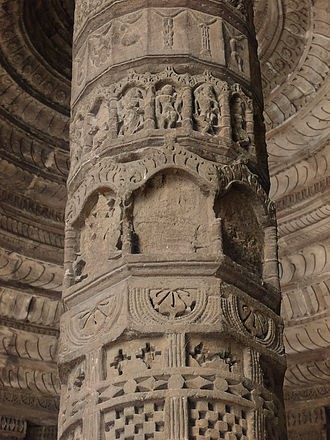
Hindu-Jain-style pillar
- Qutub Minar, Delhi
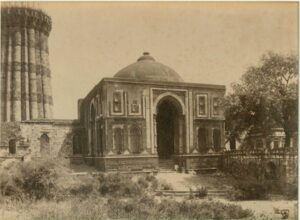 Alai Darwaza in 1870s
Alai Darwaza in 1870s
- Siri Fort
- Alauddin built the Fort of Siri (1302) and the Palace of one thousand pillars (Hazar Satun) inside the fort of Siri.
- Alauddin also built Hauz-i-Khas, Huaz-i-Ilahi and Jamayat Khana Masjid in Delhi.
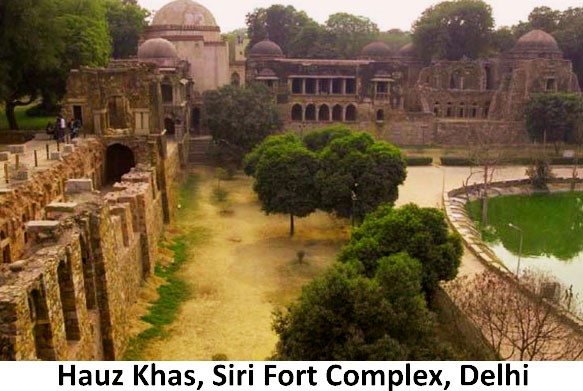 Tughlaqabad
Tughlaqabad
- Sufi structures
- Muhammad bin Tughlaq Built the tomb of Nizamuddin Auliya in Delhi near Hauz-i-Khas.
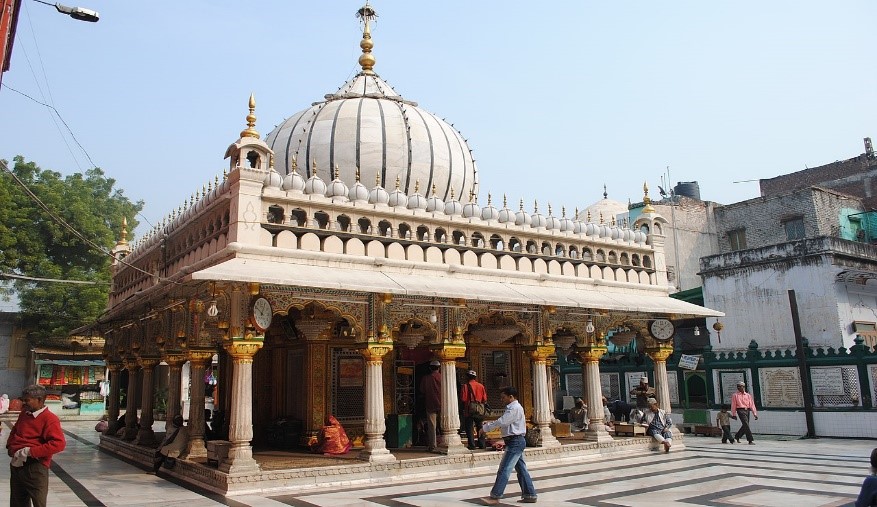
Tomb of Nizamuddin Auliya
- Contribution by the Lodhi Dynasty:
- They built buildings by assimilating the Rajasthani-Gujarati style.
- They placed their building on a high platform surrounded by For example – Lodhi garden in Delhi.
- Buildings built by the rulers for common people
- Sarais – They were primarily built on a simple square/rectangular plan and were meant to provide temporary accommodation to Indian and foreign travellers, pilgrims, merchants, traders, etc. For example, Feroz Shah Tughluq built a large number of sarais.
- Khanqah (Hospice) – It is a building made specifically for the gatherings of Sufi brotherhoods for assemblies. Qutbuddin Aibak started the tradition of Khanqahs in the Delhi sultanate. Firoz shah Tughlaq made a large number of khanqah. Hijron Ka Khanqah was built during the Lodhi dynasty.
Reasons for the downfall of the Delhi sultanate:
The Delhi sultanate suffered from various problems continuously:
- They could not manage to accommodate the roles of the Nobles in the empire, which often led to revolts and coups. Jalaluddin Khilji and Ghiasuddin Tughlaq were both high-ranking nobles of their former emperors.
- Their religious policies were often regressive, which was a constant source of instability in the empire.
- Preparation against the Mongolian attacks on the western from drained a lot of resources of the empire.
- Technology Deficit: The rulers of the Delhi Sultanate could not keep up with the constant upgradation of firearm technology in central Asia. For example, Babur could defeat Ibrahim Lodi with a small force due to the use of effective Artillery.
Conclusion: These factors led to the downfall of the Delhi sultanate and the rise of the Mughal empire. We shall later see how the Mughals dealt with these challenges in the coming pages.


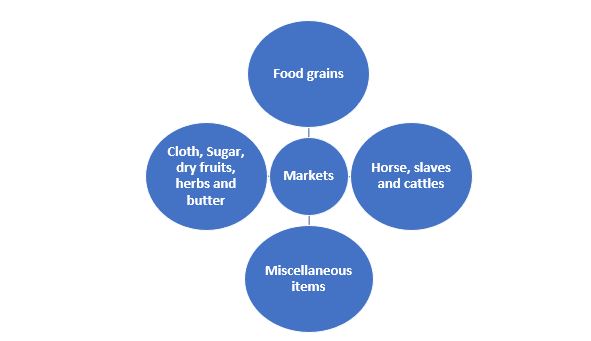
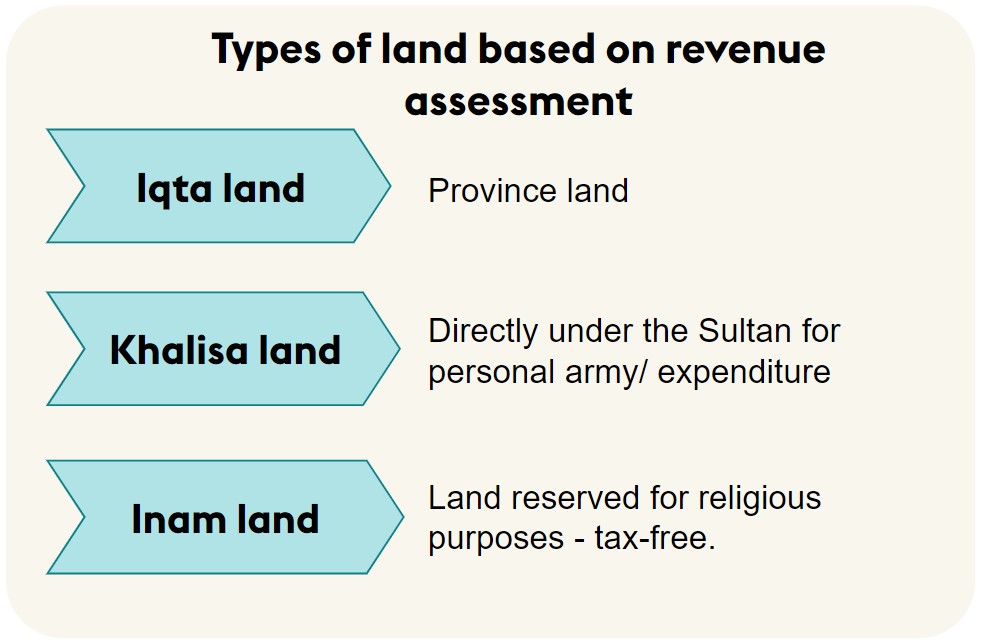

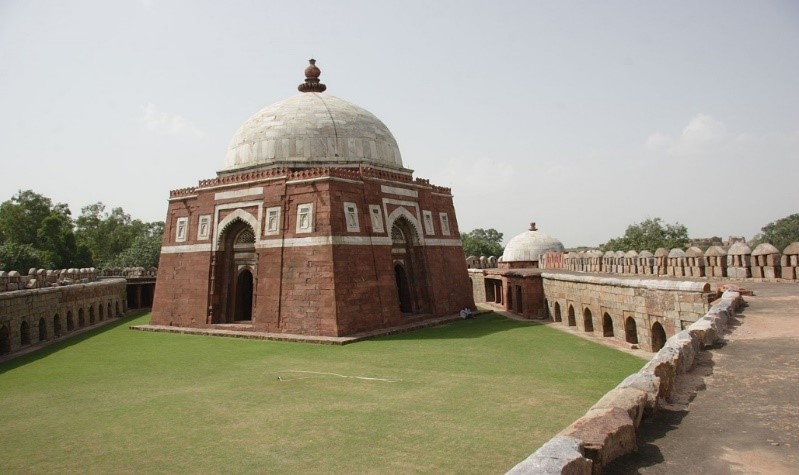



![Maratha Empire: History, Rulers, War &Amp; Administration [Upsc Notes] | Updated December 22, 2024 Maratha Empire: History, Rulers, War & Administration [Upsc Notes]](https://www.99notes.in/wp-content/uploads/2023/04/maratha-empire-featured-768x500.webp)
![Bhakti Movement: Origin, Main Principles, Causes, And Its Effect [Upsc Medieval History Notes] | Updated December 22, 2024 Bhakti Movement: Origin, Main Principles, Causes, And Its Effect [Upsc Medieval History Notes]](https://www.99notes.in/wp-content/uploads/2023/02/the-bhakti-momvement-banner-99notes-upsc-768x480.webp)

